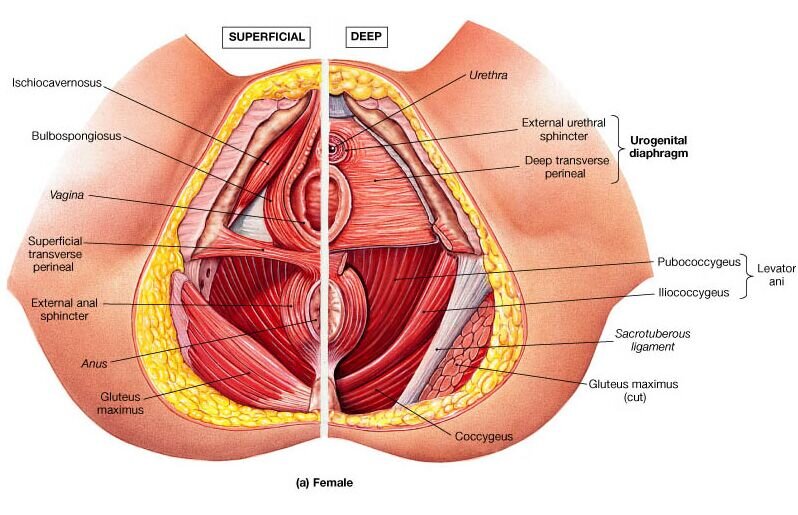The pelvic floor plays a crucial role in supporting various bodily functions, yet it often goes unnoticed until something goes wrong. Understanding this vital part of your anatomy, how pregnancy affects it, and how to maintain its strength through targeted exercises can significantly improve your quality of life. Research has shown that Pelvic Floor Muscle Training (PFMT) is an effective method for improving pelvic floor function, especially in managing conditions like stress urinary incontinence.
Anatomy of the Pelvic Floor
The pelvic floor is a group of muscles, ligaments, and tissues that stretch like a hammock from the pubic bone at the front to the tailbone at the back. These muscles support the bladder, uterus (in women), and rectum, helping control bladder and bowel movements, sexual function, and, during childbirth, the baby’s passage through the birth canal.

Key Components of the Pelvic Floor:
Levator Ani: The largest muscle group, including the puborectalis, pubococcygeus, and iliococcygeus muscles. These help maintain continence and support pelvic organs.
Coccygeus: A smaller muscle that supports the back of the pelvic floor.
Perineal Body: A fibromuscular structure that acts as a support between the vagina and rectum in women, and between the scrotum and anus in men.
How Pregnancy Affects the Pelvic Floor

Pregnancy and childbirth place significant stress on the pelvic floor. The weight of the growing baby increases pressure on these muscles, and hormonal changes cause them to stretch and weaken. Vaginal delivery, in particular, can lead to overstretching or even tearing, contributing to a weakened pelvic floor.
Effects of Pregnancy on the Pelvic Floor:
- Stretching of Muscles: The pelvic floor muscles stretch to accommodate the growing uterus and to facilitate childbirth.
- Hormonal Changes: Hormones like relaxin cause ligaments to loosen, which, while necessary for childbirth, can lead to pelvic floor weakness.
- Pressure from Baby’s Weight: The added weight of the baby increases the pressure on the pelvic floor, leading to potential weakening or damage.
Exercises for the Pelvic Floor
Pelvic Floor Muscle Training (PFMT) exercises, commonly referred to as Kegel exercises, are designed to strengthen the pelvic floor muscles. These exercises are simple but powerful tools in maintaining and improving pelvic floor health, particularly in preventing and treating conditions like urinary incontinence and pelvic organ prolapse.
Basic Kegel Exercises

1. Identifying the Pelvic Floor Muscles:
- The first step in performing Kegel exercises is to identify the correct muscles. To do this, try to stop your urine flow midstream. The muscles you use to do this are your pelvic floor muscles. It’s important to locate these muscles correctly to ensure the effectiveness of your exercises.
2. The Basic Kegel:
- Once you’ve identified your pelvic floor muscles, follow these steps:
Step 1: Sit or lie down in a comfortable position.
Step 2: Tighten your pelvic floor muscles as if you’re stopping the flow of urine.
Step 3: Hold the contraction for about 5 seconds.
Step 4: Relax the muscles for 5 seconds.
Step 5: Repeat this process 10 times per session.
3. The Long Hold:
- To build endurance in the pelvic floor muscles, try a longer hold:
Step 1: Tighten your pelvic floor muscles and hold the contraction for 10 seconds.
Step 2: Relax for 10 seconds.
Step 3: Repeat 10 times.
4. The Quick Flicks:
- Quick flicks help improve the fast-twitch muscle fibers in your pelvic floor, which are essential for preventing sudden leaks:
Step 1: Tighten and release your pelvic floor muscles quickly, as fast as you can.
Step 2: Aim for 10 quick contractions in a row.
Step 3: Rest for a few seconds and repeat.
Advanced Pelvic Floor Exercises
:max_bytes(150000):strip_icc()/Parents-GettyImages-643997575-1c73661a9316423584a066d76a6ffddc.jpg)
Once you’re comfortable with the basic exercises, you can incorporate more advanced techniques to further strengthen your pelvic floor.
1. Pelvic Floor Elevators:
- Imagine your pelvic floor muscles as an elevator.
Step 1: Slowly tighten the muscles, lifting them “up” through different “floors” or levels, increasing the intensity of the contraction as you go.
Step 2: Hold at the top level for a few seconds.
Step 3: Slowly lower the muscles back down, releasing the contraction in stages.
2. Bridge Pose:
- This exercise not only strengthens your pelvic floor but also engages your glutes and core:
Step 1: Lie on your back with your knees bent and feet flat on the floor, hip-width apart.
Step 2: As you exhale, lift your hips towards the ceiling, squeezing your pelvic floor muscles and glutes.
Step 3: Hold the position for a few seconds before slowly lowering your hips back down.
3. Deep Squats:
- Deep squats are effective for strengthening the entire pelvic region:
Step 1: Stand with your feet slightly wider than hip-width apart.
Step 2: Lower your body into a deep squat position, as if you’re sitting back into a chair, keeping your back straight.
Step 3: As you rise back up, engage your pelvic floor muscles by lifting them as you exhale.
When and How Often to Perform Pelvic Floor Exercises
Research, has demonstrated that regular PFMT is essential for maintaining pelvic floor strength and function. Here’s how to incorporate these exercises into your routine:
- Frequency: Aim to do your pelvic floor exercises at least three times a day. Consistency is key to seeing results. You can perform these exercises while sitting, standing, or lying down, making them easy to fit into your daily routine.
- Duration: Start with holding each contraction for 5 seconds, gradually working up to 10 seconds as your muscles get stronger. Ensure you relax fully between contractions.
- Postpartum: Begin with gentle exercises as soon as you feel ready after childbirth, gradually increasing the intensity as your strength improves.
Signs You’re Doing the Exercises Correctly
You should feel a lifting and tightening sensation when you contract your pelvic floor muscles. It’s important to focus on these muscles and avoid tightening your abdomen, buttocks, or thighs. If you’re unsure whether you’re doing the exercises correctly, consider consulting a pelvic floor physical therapist for guidance.
By consistently practicing these exercises, you can improve your pelvic floor strength, support your pelvic organs, and prevent or manage conditions like incontinence and prolapse. Remember, the benefits of PFMT extend beyond the short term, making it a valuable lifelong practice.
When to Start Pelvic Floor Exercises:
- Before Pregnancy: Strengthening your pelvic floor before pregnancy can help you maintain control and prevent issues later on.
- During Pregnancy: Continue with pelvic floor exercises to support the muscles as they endure increased pressure.
- Postpartum: Start pelvic floor exercises as soon as you feel comfortable after childbirth. Even if you had a cesarean section, these exercises are beneficial for overall pelvic health.
Signs of Pelvic Floor Dysfunction After Pregnancy
Pelvic floor dysfunction occurs when the muscles are too weak or too tight, leading to a variety of symptoms. After pregnancy, it’s important to be aware of the signs that might indicate pelvic floor issues.
Common Signs of Pelvic Floor Dysfunction:
- Urinary Incontinence: Leaking urine when you cough, sneeze, laugh, or exercise.
- Bowel Incontinence: Difficulty controlling bowel movements or passing gas.
- Pelvic Organ Prolapse: A sensation of heaviness or bulging in the vagina, which occurs when the pelvic organs drop due to weakened muscles.
- Pain During Intercourse: Discomfort or pain during sex, which may be due to weakened or tight pelvic floor muscles.
- Lower Back Pain: Chronic lower back pain that isn’t relieved by typical treatments might be related to pelvic floor dysfunction.
Where to Seek Help:
- Pelvic Floor Physical Therapist: A specialized physical therapist can provide tailored exercises and treatments to strengthen or relax the pelvic floor muscles. Given the proven benefits of PFMT, seeking help from a trained professional ensures that you’re performing the exercises correctly and effectively.
- Obstetrician/Gynecologist (OB/GYN): Your OB/GYN can assess your pelvic floor health, offer guidance, and refer you to a specialist if necessary.
- Urogynecologist: A specialist in female pelvic medicine and reconstructive surgery who can offer advanced care for complex pelvic floor issues.
- Support Groups: Joining a support group can help you connect with others experiencing similar issues, providing emotional support and practical advice.
Key Notes
- Pelvic Floor Anatomy: Comprises muscles, ligaments, and tissues supporting the bladder, uterus, and rectum.
- Pregnancy’s Impact: Pregnancy and childbirth stretch and weaken the pelvic floor due to hormonal changes and increased pressure from the baby.
- Pelvic Floor Exercises (PFMT): Kegel exercises strengthen the pelvic floor, with basic techniques like holding contractions for 5-10 seconds and quick flicks.
- Advanced Techniques: Exercises like bridge poses and deep squats enhance overall pelvic strength and core stability.
- Exercise Routine: Perform PFMT three times a day, starting before, during, and resuming after pregnancy.
- Signs of Correct Exercise: Feel a lifting and tightening in the pelvic floor without engaging other muscles.
- Post-Pregnancy Dysfunction: Look for urinary/bowel incontinence, pelvic organ prolapse, pain during intercourse, or chronic lower back pain.
- Seeking Help: Consult pelvic floor physical therapists, OB/GYNs, or urogynecologists for proper guidance and treatment.
- Long-Term Benefits: Consistent PFMT offers sustained pelvic floor strength, preventing issues like incontinence and prolapse.
